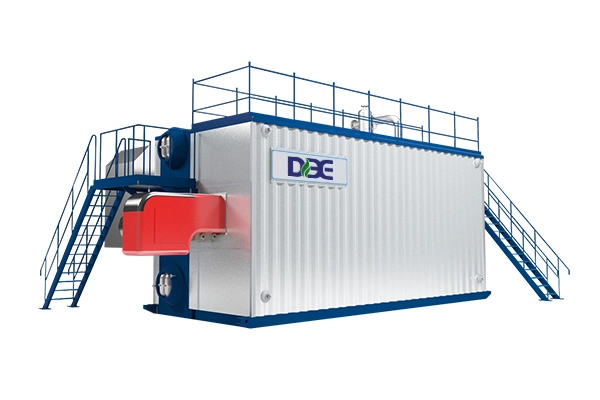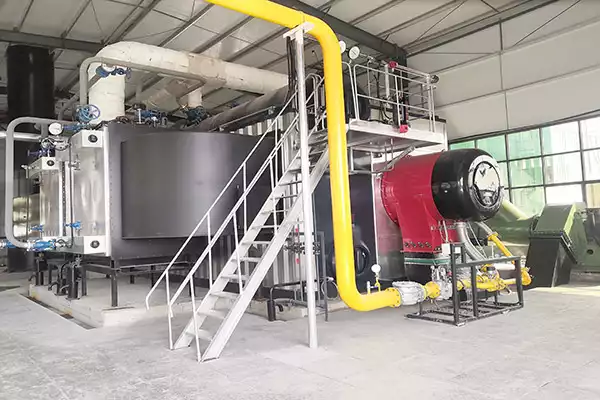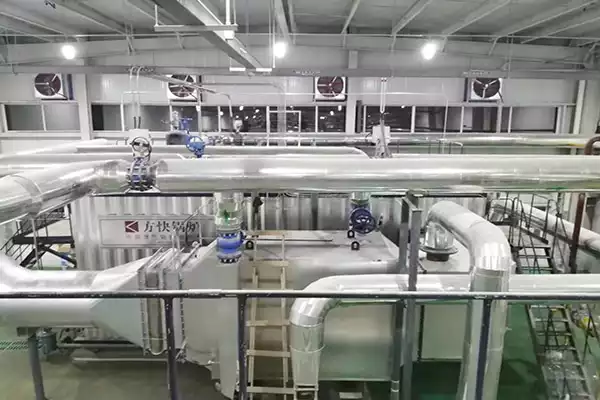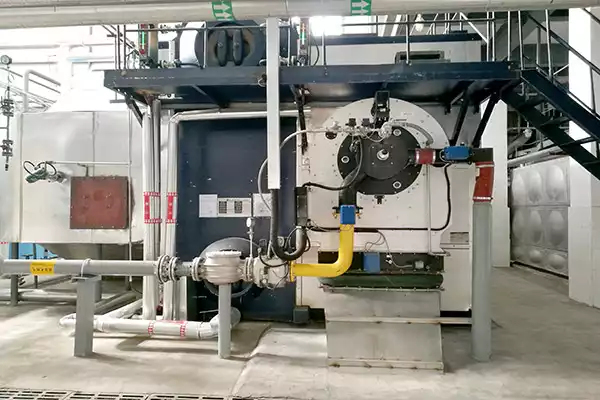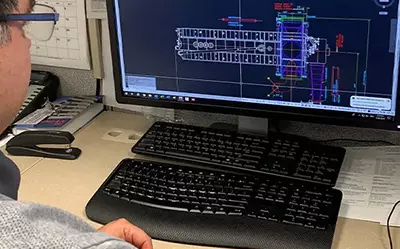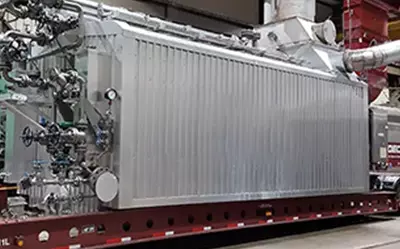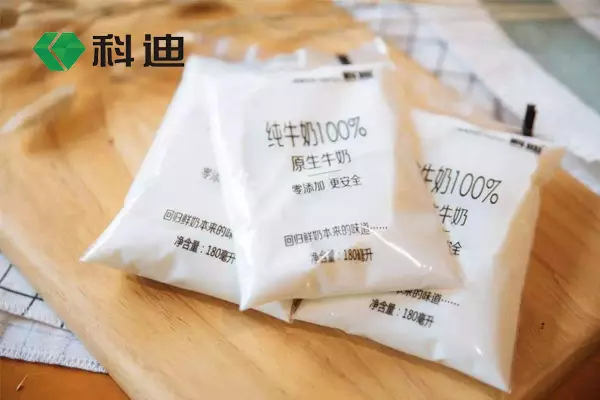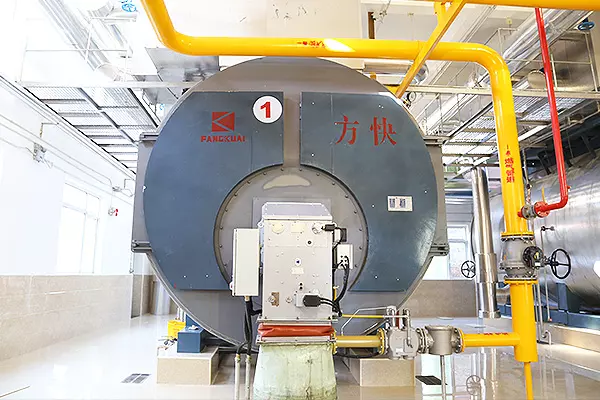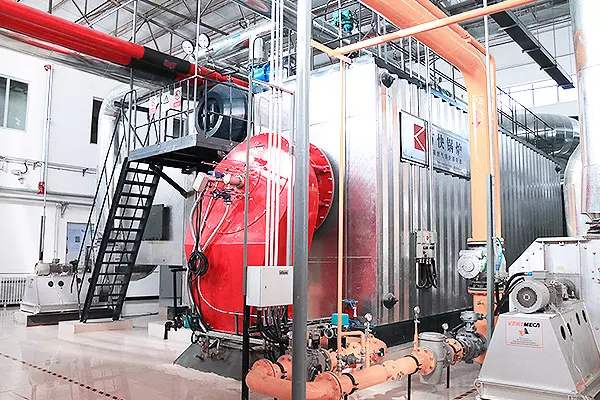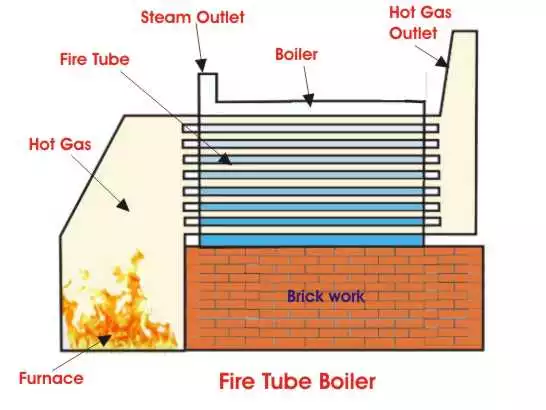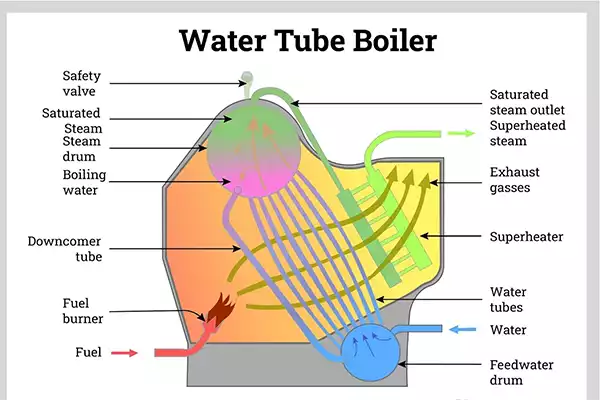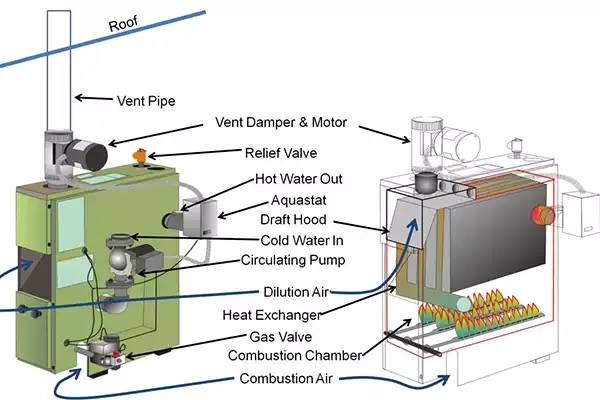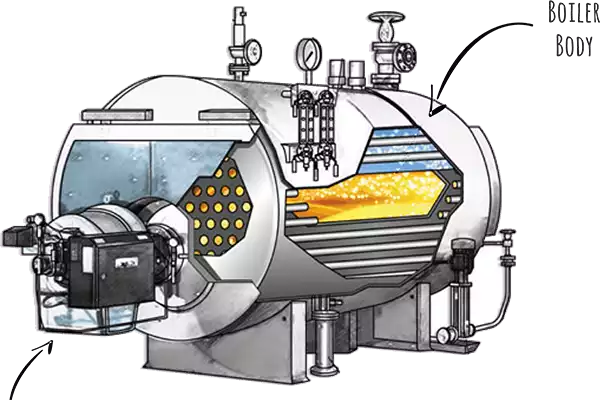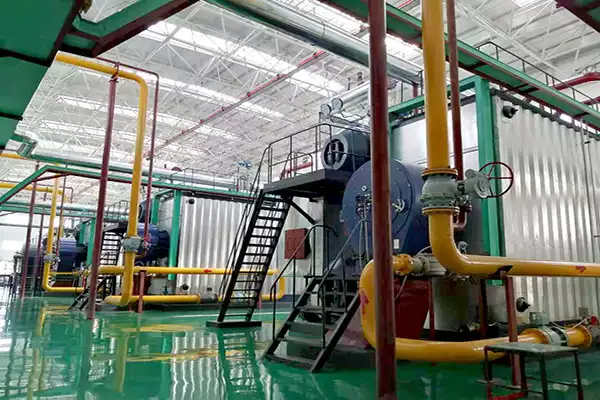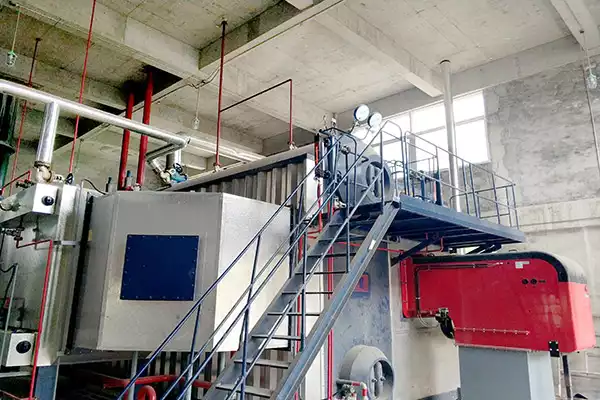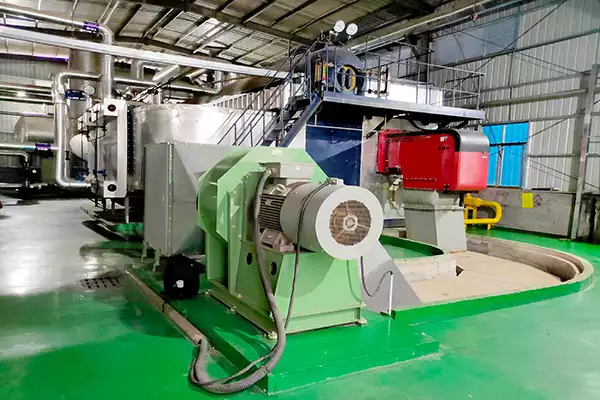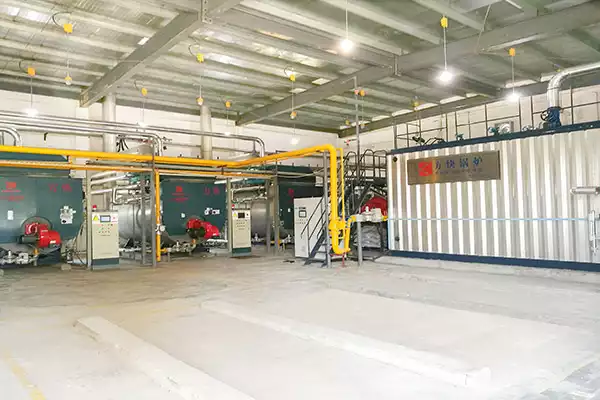introduzione
Le caldaie a vapore industriali possono sembrare reliquie del passato, evocare immagini di macchine a carbone fluttuanti fumo. Ma la moderna tecnologia della caldaia a vapore ha trasformato questi dispositivi in pulizia, efficiente, e versatili soluzioni di riscaldamento.
Come funziona il vapore industriale?
Le caldaie a vapore industriali generano vapore riscaldando l'acqua attraverso vari metodi di trasferimento di calore. Questa sezione esplora in dettaglio il processo di generazione del vapore e i meccanismi di trasferimento del calore.
Processo di generazione di vapore
La generazione di vapore inizia con una fonte di calore che riscalda un serbatoio o una camera piena d'acqua. La fonte di calore può provenire da carburanti combustibili come il gas naturale, olio, o carbone. Oppure può provenire dall'elettricità nelle caldaie elettriche.
Mentre l'acqua assorbe il calore, La sua temperatura aumenta 100°C al punto di ebollizione. In questa fase, Le bolle iniziano a formarsi come tasche di vapore acqueo o vapore iniziano a emergere.
Più calore fa bollire rapidamente l'acqua, Convertire quantità maggiori in vapore. Questo vapore sale e si separa dall'acqua calda rimanente. Il vapore si accumula nella parte superiore del serbatoio della caldaia.
Il vapore viene condotto dalla presa a vapore, di solito attraverso una valvola di pressione. Ciò fornisce vapore pressurizzato ovunque sia necessaria la sua energia termica - un processo industriale, turbina di potenza, Costruire il sistema di riscaldamento, eccetera.
Metodi di trasferimento di calore
Le caldaie a vapore industriali si affidano a tre meccanismi di trasferimento di calore per bollire l'acqua:
Radiazione: Riscaldare i radiati da una superficie calda come combustibile o una bobina elettrica. L'acqua assorbe l'energia radiante, sollevando la sua temperatura. Le radiazioni rappresentano la maggior parte del trasferimento di calore nelle caldaie.
Convezione: L'acqua più calda sorge naturalmente, Distribuire il calore mentre si sposta verso l'alto. Cascate più fredde da riscaldare. Questa corrente di convezione aiuta a riscaldare in modo uniforme l'acqua.
Conduzione: Il contatto diretto tra tubi della caldaia e fiamme o gas caldi trasferisce il calore attraverso le pareti metalliche. Questo riscalda l'acqua che circola all'interno.
Conduzione e trasferimento di convezione Calore più velocemente delle radiazioni. La combinazione di tutti e tre i metodi consente alle caldaie industriali di fornire rapidamente vapore abbondante. Il design moderno della caldaia ottimizza le radiazioni dalle fiamme, Conduzione attraverso i tubi, e convezione all'interno dell'acqua per massimizzare l'efficienza.
Tipi di caldaie a vapore industriali
Le strutture industriali hanno diverse opzioni di caldaia a vapore disponibili a seconda delle loro esigenze. I tipi principali includono tubi di fuoco, tubi d'acqua, ed elettrico, gas, e caldaie a olio.
1. Caldaie a tubo di fuoco
Nelle caldaie a tubo di fuoco, I gas di combustione caldi passano attraverso i tubi circondati dall'acqua per generare vapore. Queste caldaie relativamente compatte ed economiche sono ideali per applicazioni a vapore a bassa a media pressione fino a 15 Psi.
Il design della caldaia del tubo di fuoco è molto semplice, trasporta gas caldi dal bruciatore attraverso i tubi nel serbatoio. Il gas nei tubi riscalda l'acqua nel serbatoio per creare vapore. Poiché il tubo è circondato dall'acqua, Il calore viene trasferito dal gas all'acqua attraverso il metallo. Questo riscalda l'acqua, trasformandolo in vapore, che sorge in cima al serbatoio dove viene raccolto.
Le caldaie a tubo di fuoco raggiungono fino a 90% efficienza e sono disponibili in diverse configurazioni, compreso verticale, orizzontale, e versioni inclinate. I tipi comuni includono Cochran, Lancashire, Cornovaglia, e caldaie a tubo di fuoco locomotivo.
I vantaggi includono la loro impronta compatta, Avvio rapido, Buona versione a vapore, e basso costo. Gli svantaggi sono minori flessibilità nel rispondere alle variazioni di carico e alle minori pressioni del vapore rispetto alle caldaie del tubo d'acqua.
2. Caldaie a tubo d'acqua
Nelle caldaie del tubo d'acqua, L'acqua circola in tubi con gas di combustione caldi che li attraversano per produrre vapore. Più complesso e costoso dei tipi di tubo di fuoco, Possono gestire le esigenze del vapore ad alta pressione per gli impianti di produzione e la generazione di energia.
Le caldaie del tubo d'acqua sono costituite da un grande tamburo contenente acqua collegata a un fascio di tubi d'acqua di diametro più piccolo. I tubi hanno gas di combustione caldi che fluiscono attorno a loro. Quando il tubo riscalda l'acqua circolante, L'acqua circolante può essere convertita in vapore all'interno del tubo. A questo punto, Il vapore si alza nel tamburo per la raccolta.
Le caldaie a tubo d'acqua ottengono oltre 90% efficienza e sono disponibili sia per applicazioni ad alta pressione che a bassa pressione. I tipi comuni sono Lamont, Benson, e Caldaie loeffler.
I vantaggi delle caldaie del tubo d'acqua sono elevate pressioni a vapore e la capacità di soddisfare improvvise richieste di vapore. Gli svantaggi includono una complessità e un costo più elevati.
3. Caldaie elettriche
Le caldaie elettriche forniscono un modo rapido e pulito per produrre vapore usando l'elettricità per riscaldare l'acqua. Forniscono la temperatura del vapore di precisione e il controllo della quantità. Le caldaie elettriche si adattano alle applicazioni in cui i tassi di elettricità sono inferiori ai costi del carburante. Le spese operative elevate sono la loro principale limitazione.
4. Caldaie a gas
Le caldaie a gas bruciano gas naturale o gas LP per riscaldare l'acqua per la generazione di vapore. Forniscono vapore pulito ed efficiente con un controllo preciso ma hanno costi iniziali più elevati. Le caldaie a gas si adattano a strutture industriali di medie dimensioni.
5. Caldaie d'olio
Le caldaie a olio bruciano l'olio combustibile per riscaldare l'acqua. Sebbene più costoso da eseguire rispetto ai tipi di gas, Possono usare carburanti pesanti più economici. Lo stoccaggio e la movimentazione del carburante sono sfide. Le caldaie a petrolio si adattano alle applicazioni industriali.
Componenti della caldaia a vapore industriale
Le caldaie a vapore industriali sono costituite da vari componenti che lavorano insieme:
Bruciatore: Questo dispositivo atomizza e mescola carburante con aria per la combustione. I moderni bruciatori a disegno forzato costringono l'aria nel flusso di carburante per una combustione completa. Il bruciatore accende la miscela per rilasciare calore per acqua bollente.
Camera di combustione: Questo è uno spazio chiuso che alloggia le fiamme del bruciatore e i gas caldi. Trasferisce in modo efficiente il calore in tubi e acqua. L'isolamento mantiene il calore. Le griglie supportano carburanti solidi come carbone o biomassa.
Scambiatore di calore: Questa rete di tubi fa circolare l'acqua mentre è esposta ai gas di combustione calda. Il calore passa dai gas nell'acqua attraverso le pareti del tubo. L'acqua calda entra nel tamburo superiore, dove il vapore si separa. Thermo-Sifoning sposta passivamente l'acqua. La circolazione forzata utilizza pompe.
Drum a vapore: Questo grande serbatoio raccoglie vapore generato mentre consente la separazione delle goccioline d'acqua. Il vapore si alza nel tamburo dai tubi riscaldati. Il vapore secco quindi esce alla linea di distribuzione. Il tamburo ospita anche indicatori del livello dell'acqua.
Serbatoio di espansione: Questo serbatoio ospita l'acqua calda in espansione e la domanda di vapore fluttuante. Previene l'accumulo di pressione e mantiene costante l'approvvigionamento idrico. Una sfiato dell'aria automatica rimuove l'aria.
Valvola di soffiaggio: Questa valvola rimuove periodicamente i fanghi dal fondo della caldaia per evitare l'accumulo. Le valvole di soffiaggio inferiore drenano rapidamente l'acqua con fanghi e sedimenti. I colpi di superficie rimuovono i solidi disciolti.
Valvole di sicurezza: Le valvole di scarico della pressione rilasciano automaticamente la pressione in eccesso dalla caldaia in modo sicuro. Ciò impedisce la pericolosa sovra-pressione e l'esplosione. Le valvole si ritraggono quando viene raggiunta la normale pressione.
Controlli del livello dell'acqua: I sensori misurano il volume dell'acqua nella caldaia e i livelli di ricarica quando sono bassi attraverso valvole e pompe automatiche. Il mantenimento dei livelli idrici adeguati previene i danni.
Efficienza della caldaia a vapore industriale
Le caldaie a vapore operative massimizzano in modo efficiente la produzione di vapore riducendo al minimo i costi di carburante e energia. Questa sezione copre i metodi per migliorare l'efficienza della caldaia e i fattori chiave che la colpiscono.
Importanza dell'efficienza della caldaia
Le caldaie a vapore industriali consumano grandi quantità di carburante ed energia per fornire vapore. Anche i piccoli miglioramenti dell'efficienza si traducono in significativi risparmi nel carburante, costi, e impatto ambientale nel tempo.
I sistemi efficienti generano anche vapore in modo affidabile con tempi di inattività minimi per le riparazioni. Ottimizzando l'efficienza, Gli impianti industriali ottengono il massimo ritorno sugli investimenti del sistema di caldaia.
Metodi per migliorare l'efficienza
Vari metodi possono ottimizzare l'efficienza della caldaia a vapore:
- Preriscaldare l'aria di combustione: La preriscaldamento dell'aria che entra nel bruciatore migliora l'efficienza della combustione. L'aria assorbe il calore dai gas di combustione in un preriscaldatore d'aria prima di entrare nella caldaia. Ciò consente una migliore bruciatura del carburante con meno perdita di calore.
- Ottimizzazione dell'aria in eccesso: Il controllo del livello di ossigeno migliora l'efficienza della combustione. Troppo aria spreca il calore. I sensori regolano l'assunzione d'aria in base ai livelli di ossigeno nello scarico. Ciò mantiene livelli di ossigeno in eccesso ottimali.
- Pulizia delle superfici di riscaldamento: Fuliggine e scala sui tubi fungono da isolamento, Ridurre il trasferimento di calore. Pulizia regolare attraverso i pennelli, Blowdowns, e i lavaggi acidi li elimina. Ciò migliora l'assorbimento del calore da parte dei tubi della caldaia.
- Recupero del calore dei rifiuti: I gas di combustione contengono calore in fuga attraverso il camino. Un economizzatore recupera un po 'di questo calore di scarto per preriscaldare l'acqua di alimentazione della caldaia. Ciò riduce l'utilizzo del carburante e migliora l'efficienza.
- Monitoraggio del gas di combustione: L'analisi della composizione del gas di combustione indica l'efficienza della combustione. I sensori consentono la regolazione dell'aria, carburante, e fiamma per ridurre al minimo l'aria in eccesso e il combustibile non bruciato per la massima efficienza.
Fattori chiave che incidono sull'efficienza
Vari fattori di progettazione della caldaia influenzano l'efficienza complessiva:
Tipo di carburante: Il carburante scelto influisce sui livelli di efficienza raggiungibili. Gas naturale e olio 85 – 90% efficienza. I carburanti solidi come il carbone raggiungono 75% efficienza. I costi del carburante incidono anche le spese operative.
Design del bruciatore: I bruciatori ben progettati distribuiscono aria e carburante in modo ottimale per la completa combustione. Ciò massimizza la generazione di calore dal carburante utilizzato.
Controlli di precisione: Caldaie con intelligente, Controlli di precisione Ottimizzare la combustione per il picco di efficienza. I sensori avanzati consentono anche il recupero del calore e il monitoraggio delle prestazioni in tempo reale.
Isolamento: Le superfici della caldaia esterna isolanti riducono la perdita di calore, Migliorare l'efficienza. I tubi della caldaia isolati riducono anche la perdita di calore dai gas di combustione in fuga.
Trattamento delle acque: Il trattamento dell'acqua di alimentazione della caldaia rimuove i depositi in scala e la corrosione. Ciò mantiene le superfici di caldaia interne pulite per un migliore trasferimento di calore e longevità.
Trappole a vapore: Queste valvole impediscono la perdita di vapore dalle tubazioni, attrezzatura, e radiatori. Questo conserva l'energia che andrebbe persa attraverso perdite o sfiato.
Ottimizzazione di questi fattori di progettazione chiave si traduce nella massima generazione di vapore utilizzando carburante minimo - l'obiettivo chiave dell'efficienza della caldaia. La messa a punto e la manutenzione regolari mantengono l'efficienza elevata nel tempo.
Industria delle applicazioni
Le caldaie a vapore industriali vengono utilizzate per il riscaldamento, cucina, e sterilizzazione. Sono anche utilizzati in applicazioni industriali come le centrali elettriche. Esistono vari tipi di caldaie industriali disponibili per diverse esigenze e tipi di struttura.
Produzione di energia
Le caldaie a vapore producono vapore che può essere utilizzato per far funzionare turbine e generare elettricità. Questo è l'uso principale per le caldaie a vapore oggi, e rappresenta circa 61% del loro uso totale in tutto il mondo.
Queste macchine riscaldano l'acqua 212 gradi Fahrenheit (100 gradi Celsius). Quindi, Pompano l'acqua riscaldata attraverso i tubi nei radiatori degli edifici. Questo fornisce calore in inverno.
Questi includono ristoranti, alberghi, scuole, e ospedali, tra gli altri, che richiedono grandi quantità di acqua calda durante le ore di punta!
Attrezzatura per la sterilizzazione
Le caldaie a vapore industriali possono essere utilizzate anche come sterilizzatrici negli ospedali o nelle cucine dove avviene la preparazione dei cibi. Questo aiuta a ridurre il rischio di infezione da batteri nocivi che si diffondono utilizzando metodi tradizionali come l'acqua bollente a livelli di calore elevati (che richiede un monitoraggio costante).
Sicurezza della caldaia a vapore industriale
L'operazione di caldaia sicura impedisce incidenti e lesioni. Questa sezione copre i pericoli della caldaia a vapore, meccanismi di sicurezza, e le migliori pratiche di manutenzione.
Rischi e rischi per caldaie a vapore
Le caldaie a vapore rappresentano vari rischi di sicurezza:
- Esplosioni dalla pressione eccessiva
- Brucia da superfici calde, vapore, e acqua calda
- Asfissia da perdite di gas di scarico
- Accendi da perdite di carburante o olio
- La mancanza di acqua provoca il surriscaldamento e il danno del tubo.
- I depositi in eccesso compromettono il trasferimento di calore.
- Gli errori dell'operatore portano anche a problemi di sicurezza.
- Sono necessari meccanismi e addestramento adeguati per evitare questi rischi.
Caratteristiche e meccanismi di sicurezza chiave
Le caldaie a vapore industriali incorporano varie caratteristiche di sicurezza:
Controlli del livello dell'acqua: Gli indicatori di livello e le pompe mantengono un volume di acqua di caldaia adeguata. I tagli a bassi acqua impediscono il funzionamento senza acqua sufficiente. Questo evita che le esplosioni si surriscaldano.
Balves di sollievo a pressione: Queste valvole rilasciano automaticamente la pressione del vapore in eccesso dalla caldaia. Ciò impedisce l'accumulo pericoloso di pressione eccessiva.
Valvole di soffiaggio: Blodere verso il basso o i depositi di superficie impediscono regolarmente l'accumulo e la perdita di efficienza. Questo evita potenziali surriscaldamento e danno al tubo.
Controlli di errore di fiamma: I sensori di fiamma spengono la fornitura di carburante se si spegne la luce pilota o il bruciatore principale. Ciò impedisce perdite ed esplosioni di carburante.
Pulsanti di arresto di emergenza: Questi interrompono immediatamente l'apporto di carburante durante un'emergenza, Spegnere la caldaia in modo sicuro.
Manutenzione per sicurezza
Una corretta manutenzione della caldaia migliora l'affidabilità e la sicurezza:
- Verifica delle ispezioni regolari per perdite, corrosione, e abbigliamento componente.
- Testare le valvole di sicurezza e i controlli per garantire che si attivino quando necessario.
- Monitoraggio delle linee di alimentazione del carburante e dei tubi a vapore punti allentati.
- Il trattamento dell'acqua riduce la scala e la corrosione, che può portare a perdite o guasti.
- Una corretta pulizia delle superfici di riscaldamento impedisce l'accumulo di fuliggine e l'inefficienza.
- Con formazione e manutenzione preventiva, Gli operatori possono eseguire caldaie a vapore industriali in sicurezza per anni.
Costo iniziale
Il costo iniziale di una caldaia a vapore industriale varia da $6,500-30,000. Sono disponibili in varie dimensioni, pressione, e tipi. Il prezzo della caldaia a vapore industriale dipende da questi fattori:
Dimensione della caldaia. Una dimensione più grande significa un costo più elevato perché ha bisogno di più materiale per farlo.
La pressione della caldaia. Caldaie ad alta pressione sono più costosi di quelli a bassa pressione. Perché richiedono fogli di metallo o tubi in metallo più spessi che sono più difficili da fare di quelli sottili.
Tipo della tua caldaia industriale. Ognuno ha i suoi vantaggi per gli altri, ma viene anche fornito con i suoi svantaggi. Pertanto è importante per te sapere come funziona ogni tipo prima di decidere quale si adatta meglio alle tue esigenze!
Costo di sostituzione.
È importante sapere quanto costa la sostituzione di una caldaia a vapore industriale perché ti permetterà di essere preparato al costo di installazione e manutenzione.
Se è necessario sostituire una caldaia a vapore industriale, ci sono alcuni fattori da considerare. Il primo è la dimensione del sistema che verrà sostituito. Il costo varia in base alle dimensioni e al tipo di attrezzatura che stai cercando. Per esempio, se hai un 10-caldaia a vapore con capacità tonnellata e vuoi qualcosa di simile, quindi probabilmente pagherai in giro $25,000-$75,000 a seconda del produttore e del modello. Se invece, Stai sostituendo una vecchia caldaia da 90 tonnellate con una nuova che ha il doppio della capacità (180 tonnellate), allora costerà di più $125K-$ 300.000+.
Conclusione.
Le caldaie a vapore industriali sono cavalli di lavoro versatili che generano un vapore abbondante in sicurezza per il riscaldamento diversificato, sterilizzazione, e applicazioni di generazione di energia. Se scelto e mantenuto correttamente, Forniscono affidabili, prestazioni efficienti per decenni.
Questa guida ha coperto i principali tipi di caldaie, componenti, fattori di efficienza, e sicurezza. Con questa conoscenza, È possibile selezionare configurazioni di caldaia ottimali per le loro esigenze. Procedure di manutenzione e funzionamento adeguate mantengono le caldaie a funzionamento di picco. Comprendendo i sistemi di caldaie a vapore industriali, Le piante possono massimizzare il valore di questi dispositivi per i loro processi di riscaldamento.
Ottieni il tuo miglior prezzo
Confronta rapidamente 3 Citazioni gratuite
- Ingegnere Quick Quote
- La velocità di consegna complessiva è veloce
- Scelta finanziaria
- Bassi costi di installazione e risparmi sui costi
25 years+ of boiler R&D
Più di 20 tecnologie innovative
